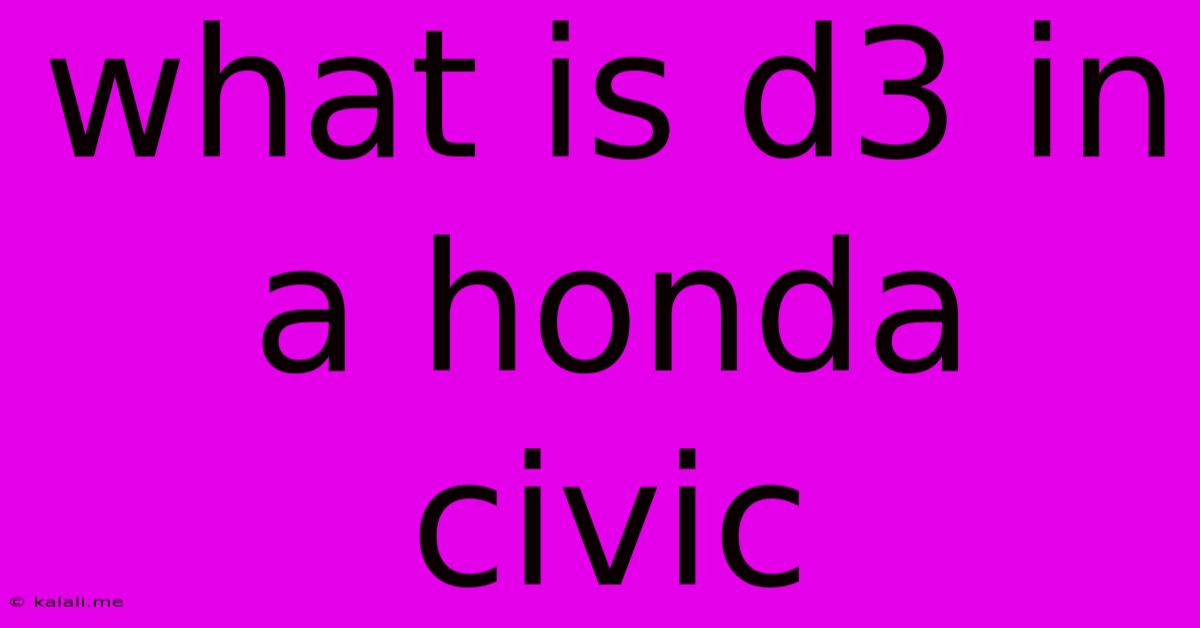What Is D3 In A Honda Civic
Kalali
Jun 03, 2025 · 3 min read

Table of Contents
Decoding the D3 in Your Honda Civic: A Comprehensive Guide
So, you've got a Honda Civic, and you're curious about that mysterious "D3" you see on your transmission? This article will delve into the meaning of D3 in a Honda Civic automatic transmission, explaining its function, when to use it, and its implications for your driving experience. Understanding this feature can significantly improve your fuel efficiency and overall driving control.
The D3 setting in your Honda Civic's automatic transmission isn't some secret performance unlock; it's a 3rd gear lock-out mode. Essentially, it limits your transmission to only using the first three gears. This simple mechanism offers several advantages in specific driving scenarios.
Understanding the Mechanics of D3
In normal "D" (Drive) mode, your Civic's transmission automatically selects the most appropriate gear based on your speed and throttle input. This aims for optimal fuel economy and performance. However, in certain situations, higher gears might be less desirable. This is where the D3 mode comes in handy. By restricting the transmission to the lower three gears, you're effectively engaging lower, more powerful ratios.
When to Use D3 Mode
The D3 mode is best suited for situations demanding greater engine braking and control, particularly when descending steep hills or towing. Here's a breakdown:
-
Hill Descent Control: D3 prevents the transmission from shifting into higher gears, allowing the engine to work harder and provide significant engine braking. This reduces the strain on your brakes, preventing overheating and extending their lifespan. You'll have more control over your speed, making descents safer and more predictable.
-
Towing: When towing a trailer or caravan, using D3 helps maintain engine RPM within a more optimal range for towing performance. This prevents the transmission from shifting to higher gears, which might struggle under the increased load.
-
Increased Engine Braking: This is incredibly useful when you need to slow down without heavily relying on your brakes, especially in challenging conditions like slippery roads or heavy traffic.
-
Improved Acceleration in Certain Conditions: While not its primary function, in situations requiring quick acceleration from a standstill (like merging onto a highway), D3 can provide a slightly more spirited launch.
Avoiding Misconceptions About D3
It's crucial to understand that D3 isn't a performance enhancement mode designed for speed. It's specifically for situations requiring more controlled driving. Driving in D3 mode at higher speeds is not recommended and can put unnecessary strain on your engine and transmission.
D3 vs. Other Drive Modes
Your Honda Civic may also have other drive modes such as "Eco" or "Sport". These modes impact fuel efficiency and throttle responsiveness, but they differ significantly from D3. D3 directly manipulates gear selection, whereas other modes adjust engine parameters and transmission shift points.
Conclusion
The D3 mode in your Honda Civic is a valuable tool for specific driving situations. Understanding its purpose and appropriate usage can enhance your driving experience and improve vehicle maintenance by reducing unnecessary wear on your braking system. Always remember to use D3 judiciously, and consult your owner's manual for detailed instructions and recommended use cases. By understanding this feature, you become a more informed and confident driver.
Latest Posts
Latest Posts
-
Archimedes Owl Sword In The Stone
Jun 04, 2025
-
Are Aerosol Spray Allowed On Planes
Jun 04, 2025
-
Splitting Llm Models Across Gpus And Cpus
Jun 04, 2025
-
How To Clean Mould Off Ceiling
Jun 04, 2025
-
How Many Soffit Vents Do I Need
Jun 04, 2025
Related Post
Thank you for visiting our website which covers about What Is D3 In A Honda Civic . We hope the information provided has been useful to you. Feel free to contact us if you have any questions or need further assistance. See you next time and don't miss to bookmark.